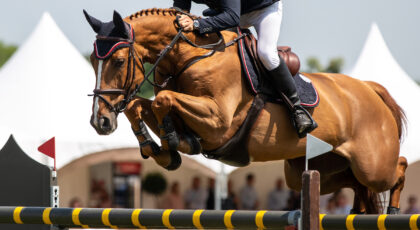Canadian grand prix rider Sean Jobin has the warm-up routine for his top international horse, Darius, down to a fine science—as in, it’s based on actual data. Here he outlines his detailed approach to warming up for a big class.
***
I put a lot of thought into ensuring my horse’s mind and body are prepared for competition.
I’ve spent a great deal of time over the years studying how top riders warm up their horses before classes. The most successful jumpers tend to average between seven to nine jumps for a warm up. Some riders even go so low as four to five jumps, very few skew higher than 10. I use that information to inform my own warm up strategy.
Lately, I’ve been very interested in how we use data and analytics to better incorporate load management techniques into our training program. To investigate that, I recruited the help of equine sports scientist Dr. Tim Worden. He and his team have collected years’ worth of data following top showjumpers competing at the Winter Equestrian Festival in Florida and provide research analysis on individual performance horses.
Based Dr. Worden’s research, as well as my own experiences and the needs of my horse, we devised a pre-competition warm up plan for my Grand Prix horse Darius. Darius is a firecracker of a horse. He gets easily caught up in the freneticism and energy of jumping, so we plan every element of his warm up carefully and track the results of different variables.
Our plan, as is standard for most Grand Prix horses, starts in the morning. Before a big class, I typically flat Darius for 20 to 30 minutes.
For the class itself, I like to have him down at the ring when he is 10 trips away and get on him when he is about eight trips away. I will spend about eight to 10 minutes warming him up at the walk, trot and canter.
Most of my warm-up exercises center on calming, stretching and focusing the horse during this phase. Darius is usually quite spooky at things outside the arena, so I work on collecting his trot and canter steps effectively with balance and straightness. I don’t practice lead changes in the warm up as they tend to get him riled up.
When I am four trips out, I start jumping.
We begin with a vertical set at a height of one meter. I jump this once off my right and left lead, and then raise the height to about 1.25 meters. I will jump three fences consecutively without breaking the canter to establish a rhythm.
After completing this set, we take a short break and reset the fence to an oxer.
Next, I will jump a 1.20 meter square oxer, followed by a 1.35 meter ramped oxer and then a 1.40–1.45-meter square oxer. Again, I jump these three fences consecutively. I try to keep these oxers a little low, only about as high as the first oxer on course. The goal is to keep Darius confident at his spread jumps.
After this set, I take a walk break and wait until I am one trip out. At this point in time, I’ll take a minute to discuss with my ground team how Darius looks and feels jumping. Having eyes on the ground is absolutely invaluable to my warm up. My team can see the horse’s expressions and technique from a better perspective than me, and can alert me to any signs or issues I need to address.
When I’m one trip away, I will jump a 1.50–1.60 meter vertical. I try to keep it simple without making it too much of a challenge for Darius. I keep a ground rail and two poles on the vertical, and approach with regular speed. I will try to get him to really rock back on his haunches and study the vertical, as he can be overly excitable in the ring and jump too flat at his verticals.
Having finished the warm up, we head to the in-gate for boot check. I’ll usually have about two to three minutes at this point to let Darius recover. This is our optimal timing based on heart rate data we have accrued over the past year using our HyloFit system. As fitness varies per horse, heart rate data takes the guessing game out of how much time my horse needs precisely to fully recover. It also ensures I don’t overestimate and make him stand around for too long in between his warm up and his Grand Prix round.
For the jump off, we are still workshopping the perfect warm-up system.
At this point, I’m pretty happy with just four jumps to warm up. Starting with a 1.20 meter vertical, a 1.30 meter ramped oxer and then a 1.40 meter ramped oxer. We take a short walk break followed by a 1.50 meter vertical.
So far, this system appears to be working for Darius. In Ocala this past winter season, he put a clean first round in three of the four Grand Prix we contested and jumped double clear in all but one, finishing in the top seven in each.
The next step in our program is to better understand the psychological aspect of load management. This is something extremely important to most modern athletes, tracking information like quality of sleep, mental state, confidence levels, etc. We think this is going to require a bottom up approach with our groom team members collecting a lot of this data.
Much of riding is about feel, of course. But all riders are looking for ways to make marginal gains in their performance. Using data is one that works for me.
Canadian Sean Jobin is an internationally recognized Grand Prix rider based in Ocala, Florida where he runs Double Clear LLC and rides for sponsors. Learn more about Sean at doubleclearllc.com.


 April 10, 2018
April 10, 2018 

























